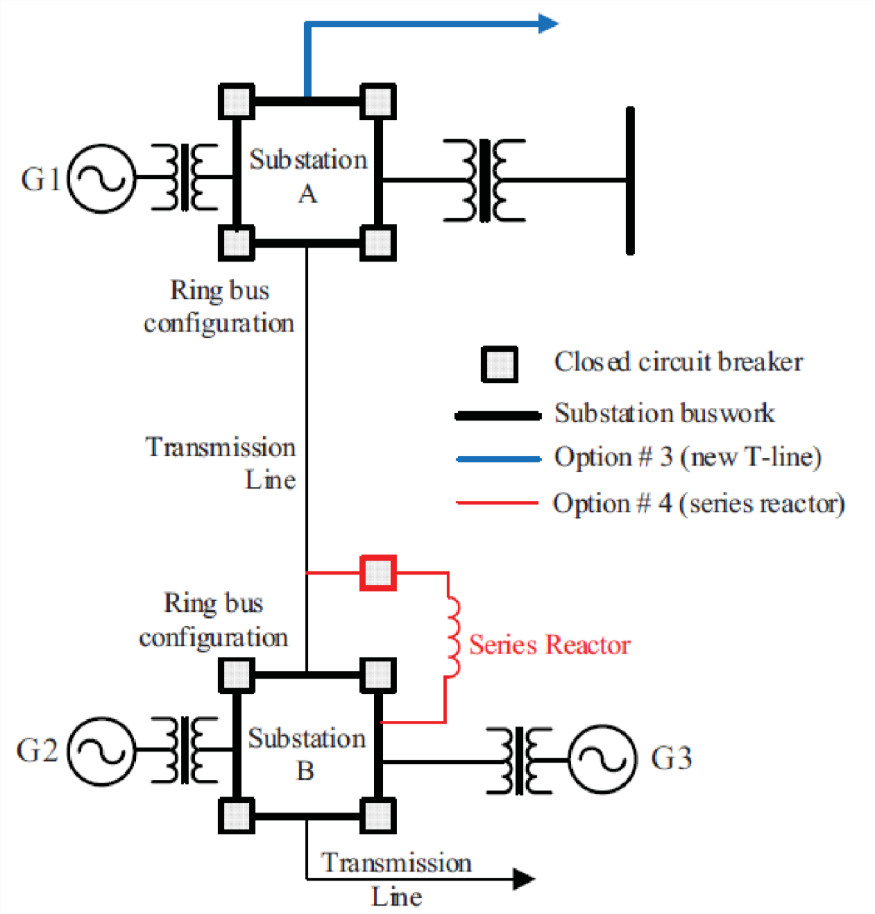
What is Power Generator Tripping?
In this topic, we discuss the Power Generator tripping due to reclosure of Transmission line. When a transmission line is connected to a power generator, the generator may experience a sudden change in power at its terminals. We have to find the cause of the change in power. The magnitude of sudden power change due to switching of transmission line is a function of angle across the open circuit breaker when opened. A more substantial angle difference corresponds to a more significant power change at the generator. When these sudden power fluctuations reach a critical threshold, they may inflict permanent damage on the generator’s shaft. This paper aims to introduce a methodology for calculating near real-time power fluctuations. The data was obtained from relay operation event and compared with the simulation results. After comparing results, the cause of sudden change in power was settled and the new setting of relay operation was implemented, to prevent the tripping of generator in future. We demonstrate the effectiveness of this methodology through practical planning and operational scenarios.
Introduction
Generator tripping protection is a system of relays and other devices that protect generators from damage by automatically disconnecting them from the power system when certain conditions are met. Generator protection helps to prevent damage to the generator, protect the external system, and maintain system stability. The techniques which are used for generator protection from tripping are High-speed reclosing and Synchro-check relays which can help to minimize the time that the line is de-energized, which can reduce the risk of transient overvoltage’s and synchronization problems and Synchro-check relays are used to ensure that generators are synchronized before the line is reclosed. The activation or deactivation of electrical components, whether they can be transmission lines or autotransformers, gives rise to electrical transients such as power oscillations, which have the potential to inflict harm on adjacent turbine generators. Power generators tripped unexpectedly after a transmission line switching event. An investigation was initiated to understand the causes of the tripping, and it involved analyzing relay data, considering the closing angle of the switch, and conducting dynamic simulations to better understand the event and propose mitigation measures. We would find the cause of tripping of generator and find its solution to avoid from generator tripping. There are following sections that we would like to discuss in this paper are need for improved study methodology to determine sudden change in power, conventional strategies for mitigating closing angle issues, application of closing angle program, program design, solution procedure and conclusion.
In order to find the cause, we have to fully understand the concept of power oscillation phenomena. Therefore, power flow of generator diagram is given below:
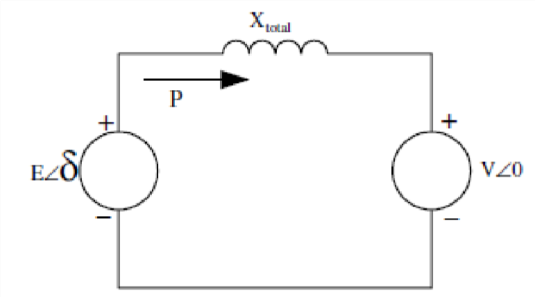
The sudden change in power can be find through this formula:
where P is the active power flow from the generator to the infinite bus in steady-state, E is the generator terminal voltage, V is the infinite bus voltage, is the angle between the generator terminal voltage E and the infinite bus V, and X the total equivalent reactance between the generator terminal bus and the infinite bus.
When a transmission line is switched in or out of service, it has been observed that X and are suddenly changed. Due to change of reactance and angle produces a sudden change in power. After that generator control system reacts and try to bring back power output of generator to steady state value before event. The electrical power output of the generator in a dynamic simulation of a nearby transmission line that was reclosed at t = 1 second. The simulation results are given below:
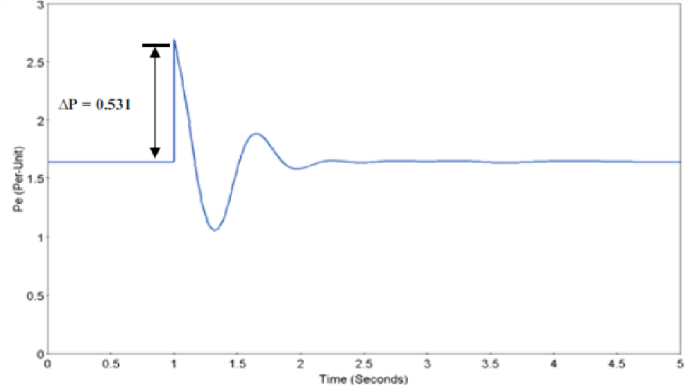
In order to find the sudden change in power we take time in seconds on x-axis and power in per unit on y-axis. Our goal is to find sudden change in power, as graph indicates that the sudden change in power is 0.531 per unit.
During a dynamic closing angle simulation in a power system, the active power output of a generator can vary due to several factors. The dynamic closing angle simulation typically involves the study of transient stability in the power system, especially during the occurrence of a fault or disturbance. In this case the disturbance is due to the sudden change in power.
Literature Survey
The “Distributed Generation and Reclosing Coordination” work focuses on Telecommunication based protection approach for addressing the automatic reclosing challenge in transmission lines. The method involves conducting simulations using PSCAD software, commonly utilized for modeling power systems and protection relays. Simulation results identify fault cases in the generator, considering various configurations in the network. Alternative methods, such as distribution line carrier or ripple signal-based approaches, are explored, particularly in scenarios with multiple connected units to the feeder and adjustable network configurations. Validation of the proposed method includes simulation studies, fault analysis, and the determination of required protection measures to ensure secure automatic reclosing and prevent phase re-closing. Speed is highlighted as a crucial factor, emphasizing the need for rapid disconnection of distributed generation units to achieve high-speed reclosing while allowing for arc extinction. However, the paper acknowledges limitations. It points out that passive methods and active methods exist as alternatives to the telecommunication-based approach. Passive methods may lead to nuisance tripping of generating units, while active methods operate based on destabilizing the island, potentially impacting grid dynamics adversely. Therefore, careful consideration is required in choosing the most suitable protection method for specific scenarios.
“The Generator Tripping due to Re-closure of a nearby Transmission Line: Investigation and Mitigation” paper revolves around the Closing Angle, Generator Protection, Sudden Power Change, Transmission Line Re-closure, Dynamic Simulation. The method used in this paper to protect the generators from tripping is Dynamic Simulation of the tripping event. On the base of closed simulation results, the cause of the sudden change in power sue to reclosing of transmission line was found and the new setting was implemented using the near simulation results to prevent further generator tripping in future. Generator tripping due to reclosing of transmission include some valid points which includes modelling and simulation of the generator tripping, field data and case studies, comparing the results of similar events and long-term impact analysis. The dynamic models for synchronous generators consist of the generator model, excitation system model and the turbine model. The Dynamic simulation using Siemens or PTI PSSRE software’s, typically used for steady-state and stability studies, was used for this evaluation. The plant overcurrent relay settings for each unit should be reviewed closely to avoid unnecessary generator tripping in the future. To avoid the generator from tripping unexpectedly, the overcurrent relay should be set to introduce a deliberate time delay before activation instead of triggering instantaneously. The lack of comprehensive or high-quality data regarding specific incidents or scenarios might limit the depth of the analysis. Incomplete data could restrict the accuracy of the findings. If the study relies on models or simulations, assumptions made within these models could introduce limitations.
“Screening Study of Sudden Power Change on Generators due to Transmission Line Re-closing” paper concentrates on Generator protection, dynamic simulation, line loading, automatic reclosing, synch-check relay. The first method is by ramping down the power output at Substation, the angle across the open breakers would be reduced, therefore, the sudden power change would be reduced as well. The second and third method is adding new elements to the study area. The main focus of the study at this point was to study future systems to determine the impact of the closing angle issue on the system of the near future. The validation of Screening Study of Sudden Power Change on Generators due to Transmission Line Re-closing accurate modeling, validating with field data, sensitivity analysis and case studies to affirm the study’s conclusions. The dynamic simulation of the event includes Preparation of dynamic ready power flow case and preliminary results from Dynamic Simulation. Limitations of a study on sudden power changes in generators due to transmission line re-closing might include reliance on available data accuracy, the study’s specific applicability to certain generator types or conditions, and potential oversights of unaccounted external factors influencing sudden power changes.
Methodology
In evaluating sudden change in power, we often use these terms such as closing angle, switching transients, transmission line switching. When exploring generators responding to transmission switching events, typically two analyses are conducted: one assessing reactions to Circuit Breaker (CB) openings following line faults and the other focusing on responses to Circuit Breaker (CB) reclosing. This paper concentrates on reclosing events due to their controlled nature, efficiently implemented using techniques for testing on power flow cases. The key factors influencing generator response to nearby transmission CB closures are the angle across the breaker and line loading post-closure. Previous work introduced a screening method aiming to limit sudden power changes in machines to under 0.5 per unit (p u), crucial for turbine generator life. However, a challenge lies in swiftly computing these changes in large power flow cases. The paper’s goal is to develop an automated process and tool using Python to identify open transmission lines within the system, simulate their closure, and compute sudden power changes in online generators. If changes exceed 0.5 per unit, an alarm alerts operators for necessary corrective action to prevent potential damage upon line reclosure.
The evaluation employed a positive-sequence power flow model with corresponding dynamic models for Flexible AC Transmission Systems (FACTS) and generating facilities, such as Static Var Compensators and synchronous generators. Siemens/PTI PSS®E was used for dynamic simulations, incorporating actual system conditions from the Energy Management System (EMS) cases, particularly during switching events. An overcurrent relay was set at a pickup of 0.87 CT rated current without time delay. This setting was coordinated with the generator’s rated current. However, unexpected power changes due to nearby line switching might surpass the relay’s threshold, causing an unintended trip of the generator. During dynamic simulation, events were replicated. When the line was re-closed at 0.03 seconds, a substantial power change tripped the generating units, akin to the real incident. Conversion from per unit values to the actual 500 kV system values was necessary for comparison. The simulation closely matched actual measurements during the switching event.
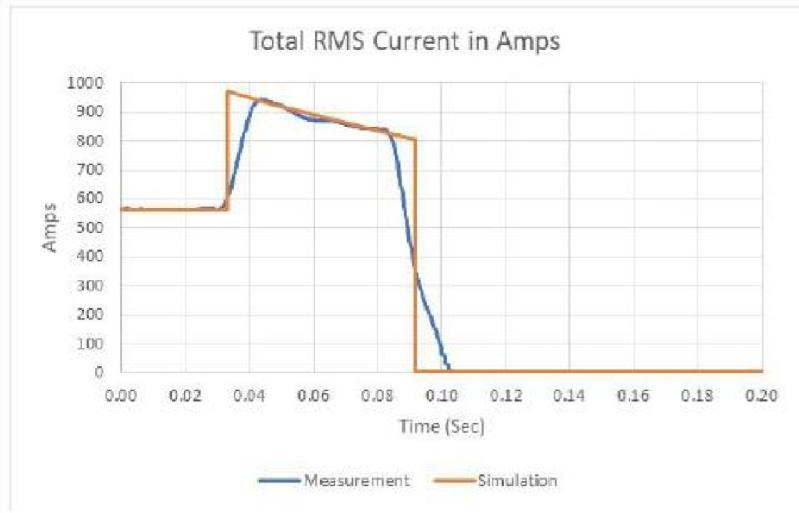
In this simulation, we compare the total rms current at 500kV, so we take Time (Sec) on x-axis and on y-axis we take current (I) which is in Amperes (Amps). The orange graph shows the simulation result, and the blue graph shows the measurement result, which is little varied in comparison to measurement.
A second scenario involved a simulation without tripping the units, assuming a delay in the unit relay. The power variation during the line re-closure was observed. The power changes following the re-closure should quickly dampen within a couple of seconds, minimizing the impact on the unit. The maximum expected power change from this unit was about 0.45 per unit, deemed acceptable per industry guidelines.
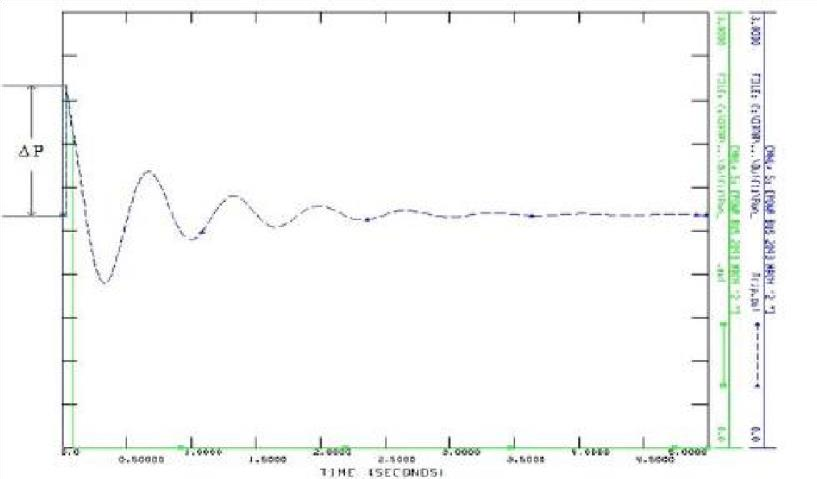
In this simulation of generator tripping, we take time (seconds) on x-axis and power (per-unit) on y-axis. We find the sudden change in power with generator tripping which is in green color and then we perform without tripping the generator which is in blue color. To prevent undesired generator tripping, it’s recommended to adjust the generator overcurrent relay to include a proper time delay, rather than an instantaneous trip.
In addressing closing angle issues, the industry recognizes four key methods in which two can be tactically implemented without additional equipment, while the other two necessitate the installation of specific transmission gear in the problematic zone. These methods encompass a range of strategies in which the first strategy is to reduce the output of nearby generation gradually and there is a method employed to limit the abrupt power change to a level below 0.5 per unit. The second strategy involves designing a customized switching scheme to alter the system, thus reducing the power flow through the targeted breaker.
The third method involves the addition of either a new transmission line or a power transformer, creating an alternative path for power flow. This additional route helps diminish the overall power flow through the reconnected line. Lastly, implementing a reactor in series with the circuit breaker serves to reduce power flow during closure. The reactor operates temporarily to alleviate power flow through the breaker, subsequently being switched out of service to minimize line impedance. These methods offer varied approaches to mitigating the challenges associated with closing angle issues in transmission systems.
There is an example given to understand the methods for mitigation closing angle issues. In this given example, between substations A and B, there’s a problem with the closing angle (when the power suddenly changes by more than 0.5 per unit). To fix this, there are four options. The first is to reduce the output of generators G1, G2, and G3 until their sudden power changes are less than 0.5 per unit. The second option involves using a special switch setup to change nearby lines or transformers and reduce power flow through the problematic breaker. Option three suggests adding a new line or transformer at either substation, giving power another way to flow and lessening the sudden power change when the line is closed. The last option is to put in a special type of reactor with the breakers that are being closed. This would cut down the power flow through the breakers and reduce the sudden power change. The reactor works temporarily and is then turned off to ease the line’s flow.

The application of closing angle program is assists BES decision-makers in detecting closing angle issues, offering two immediate actions: lowering generation or utilizing a pre-established special switching scheme. New transmission facilities are not promptly deployable by operators. Lowering generation or implementing a switching operation swiftly resolves the issue, restoring the system to its original state without delay.
In this paper, Network Real-Time Control and Protection process is used to study that can automatically identify near-real time closing angle issues on the BES using a program referred to as NRTCAP (Network Real-Time Control and Protection). The process begins by collecting required input parameters and data, after that opens the power flow case for analysis. Collect machine and transmission line specifics then execute the transmission line switching. Check for additional lines requiring examination. Iterate the line switch process for all lines. Also, analyze the gathered data then present simulation findings to the user. The flowchart of this process is given below which helps to understand the process easily:
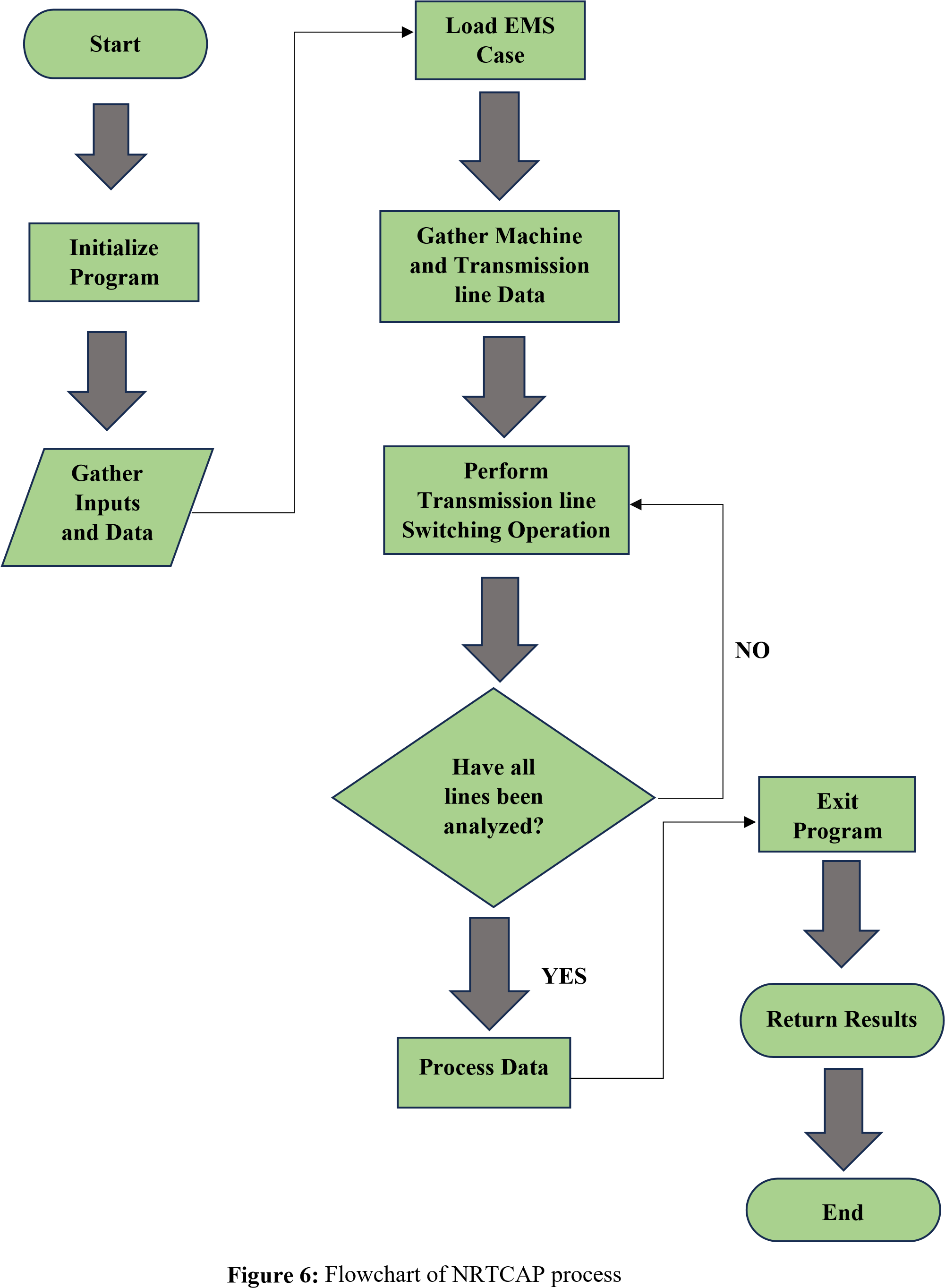
Network Real-Time Control and Protection (NRTCAP) utilizes the PSS®E raw format generated by the state estimator within Southern Companies’ Energy Management System. These snapshots provide real-time data on the company’s portion of the Bulk Electric System (BES) and adjacent utilities systems. By analyzing this data, NRTCAP identifies potential risks associated with the reclosure of transmission elements, particularly focusing on generator damage due to closing angle issues.[7]
The process involves converting the PSS®E raw format to a faster-to-process PSS®E .sav case, enabling swift analysis. NRTCAP compiles lists detailing out-of-service transmission elements, current and maximum generator outputs, and other relevant parameters. These lists form the basis for analyzing potential problems after line switching.
The program then systematically conducts line re-closures, assessing each closure’s impact on the system’s stability by observing changes in generator power outputs. It calculates the risk using a predefined equation and reports any line closures that surpass the user-defined threshold for potential generator issues. NRTCAP generates two outputs: a text file listing lines that, upon closure, exceed the user-set limit for generator stability, and a notification indicating any identified closing angle issues. The output is shown in given below figures:


The methodology, inclusive of NRTCAP, underwent validation through two distinct approaches. Initially, it was validated against six confirmed locations exhibiting closing angle issues within the Southern Company BES. NRTCAP accurately identified the sudden power change magnitudes for each of these locations, as detailed in Table I. Additionally, a list of these known locations with closing angle issues within the Southern Company BES is provided in the same table, using code names for security purposes. The second validation method involved analyzing a year’s worth of
EMS cases (around 87,000 cases) generated by the EMS state estimator program for the year 2017.
NRTCAP effectively assessed these cases, confirming the absence of any closing angle issues throughout the analyzed year.
Moreover, this methodology offers the advantage of being deployable to any utility Power Coordination Center (PCC). It enables these centers to identify closing angle issues in near real-time using the most recent EMS case, created approximately every six minutes. The intention is for PCC Operators to utilize this tool, leveraging the information to take suitable measures to address any identified closing angle issues.
A potential avenue for further exploration involves using this method to monitor the angle difference between terminals of closed lines and correlating specific angle difference magnitudes with sudden power changes observed in generators. This entails studying generation zones and adapting the method to open and record angle differences before reclosing lines to observe resulting changes in power generation.[8]
Conclusion
This paper introduces an efficient methodology for near real-time assessment of sudden power changes and an automated Python program designed to promptly detect closing angle issues on the BES. Validation of this methodology occurred through two distinct approaches: against Transmission Planning cases with known closing angle issues and against a year’s worth of EMS cases. When tested against Transmission Planning cases with known closing angle issues, NRTCAP successfully replicated previously identified findings. However, during validation against the EMS cases, no closing angle issues were detected. This absence of issues is due to the specific conditions required for a closing angle issue to manifest—typically occurring when a significant power flow ensues across a recently closed breaker. These conditions are well known and manageable within the Southern Company BES. However, this methodology remains valuable for identifying previously unknown closing angle issues within the system.
The unexpected unit tripping event was successfully reconstructed as demonstrated by the close match on the measured vs. simulated total current from the plant at Substation T.G. It was concluded that the plant overcurrent relay settings for each unit should be reviewed closely to avoid unnecessary tripping in the future under similar conditions.
Future work
The proposed methodology can be extended in several ways to further improve its performance and applicability. One future direction of research is to develop a more accurate model of the generator. The current model of the generator is based on a simplified circuit diagram. A more accurate model could be developed that considers the detailed electrical characteristics of the generator, such as its reactance, resistance, and inertia. This would allow for a more accurate prediction of the sudden power change experienced by the generator. Another area of future research is to investigate the use of real-time data. The current methodology only uses historical data to identify potential closing angle issues. Real-time data from the transmission system could be used to improve the accuracy of the methodology. For example, real-time voltage and current measurements could be used to estimate the phase angle difference across the breaker poles. In addition to developing a more accurate model and investigating the use of real-time data, future research could also focus on developing a decision-making algorithm. The current methodology does not provide a decision-making algorithm for determining whether or not a transmission line should be reclosed. A decision-making algorithm could be developed that considers factors such as the magnitude of the sudden power change, the generator loading, and the availability of other transmission paths. Finally, future research could also focus on testing the methodology on a real-time power system simulator and applying the methodology to a real-world transmission system. The current methodology has been tested using a simplified power system model. It would be beneficial to test the methodology on a real-time power system simulator to validate its performance in a more realistic environment. Additionally, the current methodology has been applied to a hypothetical transmission system. It would be interesting to apply the methodology to a real-world transmission system to see how it performs in practice.
Credit: This article has been written by ATTIQ BAIG and MUHAMMAD ZEESHAN.
